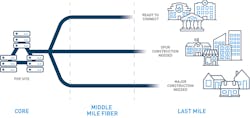How the Middle-Mile Can Help Meet Your End Goals
The need for broadband has never been greater. The question is no longer whether broadband is critical for daily life, work, or entertainment, but how much capacity is deemed necessary for these pursuits. Forward-thinking entities are racing to answer this challenge by designing, advocating for funding, and building fiber optic facilities to the premise (FTTP) or last-mile fixed wireless (FW).
Traditional and legacy built Middle-Mile infrastructure is often owned by the private sector and controls the gambit including the price for Internet connections, location of fiber, etc. With today’s new impetus to act, Middle-Mile networks can now be built by public or private entities providing a solution to expand broadband to unserved or underserved regions.
One of the biggest challenges comes from entities such as cooperatives, municipals, or counties being unsure of entering the Communications Service Providers (CSPs) arena. The skill set required to successfully navigate this space is daunting to those entities which have only offered traditional utility services such as electricity, gas, and water. Running a successful broadband service creates the need to address cybersecurity concerns, routed infrastructure design and upkeep, tier-1 interconnects, IP address allocation, and staffing skill set considerations.
This list is a bit overwhelming for entities that have not been involved in the telecommunications space. Due to these concerns, many utility or municipal entities are understandably a bit gun shy to enter the arena. The pressure to act, however, continues despite these concerns, due to constituents or cooperative members contacting their board of directors and/or local government leaders to plead for them to investment in connecting their home or business to high-speed Internet, especially in rural areas. In many of the most under or unserved portions of the country, these same constituents know the Internet will not come without leveraging these new federal resources.
At the same time, with an unprecedented amount of public and private funding available for improving broadband infrastructure, many states are deploying, getting ready to deploy, or wondering how to best utilize the federal funds to build and expand broadband access to the under and unserved.
Why Middle-Mile?
Given the Internet related challenges nationwide, Middle-Mile is one “segue” solution that is being adopted, and those that adopt this mindset early will lead the way for many across the country. With ARPA funding rules set, many states are realizing there are major benefits if they can facilitate construction of and utilize Middle-Mile infrastructure. Open-access, Middle-Mile infrastructure can provide high-speed Internet access that is both reliable and affordable. It can also allow many consumers a choice of CSPs because it will create competition that will ultimately drive prices down.
Traditional and legacy built Middle-Mile infrastructure is often owned by the private sector and controls the gambit including the price for Internet connections, location of fiber, etc. With today’s new impetus to act, Middle-Mile networks can now be built by public or private entities providing a solution to expand broadband to unserved or underserved regions. CSPs can use this infrastructure as a building block to design and build last-mile connectivity. For those entities, such as cooperatives, municipals, and counties which are “gun shy” about entering a formal CSP business model, they can utilize and monetize their existing rights-of-way (both aerial and underground) to incentivize last-mile construction. For a competitive CSP with existing infrastructure and consumers, adding Middle-Mile routes to allow access to new markets and needed tier-1 interconnects can make compelling financial sense. These routes can also be designed to tie multiple regional carriers together, increasing networking potential and ultimate reach.
Building a Middle-Mile which traverses a given geographic region while networking through existing routes can enable connectivity to “carrier-hotels” where CSPs gain access to more competitive choices for upstream bandwidth to handle consumer growth. It can also create a “win-win” mentality for those entities trying to address the under and unserved demographic within their footprint (i.e., co-op or municipal members or constituents).
Partnerships Are Key
Middle-Mile infrastructure partnerships allow utilities and broadband providers to capitalize on expertise from each side of the business. By facilitating Middle-Mile connectivity, entities can enhance broadband deployment to communities, and in turn foster economic development by enticing new businesses into their geographic region. Middle-Mile can further attract CSPs which are looking to expand their footprint with more affordable route options that can be created with the new infrastructure. Additional economic development opportunities exist, including facilitation of community anchor institutions and industrial parks, which typically require higher capacity, dedicated bandwidth.
There is a growing opportunity on both state and federal levels to fund these Middle-Mile projects. As more companies recognize the value, these funds are being used to fast-track success. Many of the grant agencies recognize this value and routinely award premium “points” for applications showing partnership potential, especially through public- private consortiums.
The true strength of the partnership model comes from 2 or more entities leveraging their existing skill sets and assets to bring enhanced opportunities to members and constituents. For a cooperative or municipal, which owns existing rights-of-way and knows how to manage and maintain cable/messenger or UG infrastructure, it is not an unruly burden to maintain a Middle-Mile physical infrastructure and pole attachment organization. By partnering with a CSP looking for attractive corridors to last-mile or regional connectivity potential, the model can create great synergies.
One of the key considerations to creating a successful Middle-Mile partnership, however, is in finding the right fit for mutual benefit. Expectations and considerations for maintenance, make-ready, growth, and ongoing expansion must be crystal clear up front for both parties to see “win-win” potential. There are always challenges in this process but finding an engineering firm with experience and expertise in this area can help with formulating the correct nomenclature for such agreements. This framework is not new to the industry and thankfully, many examples can be utilized to showcase how a partnership can best be structured for success.
Technology Utilized
While Middle-Mile infrastructure is traditionally thought of for enhancing last-mile (FTTP) fiber optic connectivity, it can also enable wireless CSPs (WCSPs) to improve capacity through fiber-to-the node (FTTN). Enhanced capacity can be realized for any last-mile provider by allowing appropriate backhaul to support continuously changing consumer demand requirements.
In addition to the last-mile capacity enablement, additional fiber optic path strands can also be expanded into multiple paths through wave utilization such as dense or coarse wavelength division multiplexing (DWDM and CWDM). Utilizing a single strand to perform multiple path functions via multiplexing can significantly reduce allocation costs for CSPs looking to secure attractive Indefeasible Rights of Use (IRUs) which enable long term rental of fiber optic facilities.
Once entities can secure appropriate transport via a given path through a region and multiple providers, they can seek carrier (fiber) hotel interconnection. The “meet-me” room for a given hotel, which is typically located in a dense urban city within a given region, will allow direct termination access and integration of tier-1 providers from all over the country, thereby opening many competitive source options for bandwidth, voice, and video.
One of the key considerations to creating a successful Middle-Mile partnership, however, is in finding the right fit for mutual benefit. Expectations and considerations for maintenance, make-ready, growth, and ongoing expansion must be crystal clear up front for both parties to see “win-win” potential.
Why Now?
Funding, funding, funding! With the plethora of federal, state, regional, and local funding opportunities and even expertise available today, entities have more options than ever to see projects come to fruition. In the recent federal infrastructure bill, broadband Middle-Mile funding will have a dedicated program from NTIA, and an eligible activity listed in the American Rescue Plan (ARPA), but the energy sector allocation is an even greater piece of the pie allowing smart-grid enhancement through potential Middle-Mile construction. It has been over a decade, plus since a dedicated source of funding has been identified in multiple funding bills for Middle-Mile, now is the time to act.
Additionally, by utilizing existing pole lines to enable aerial fiber optic construction, a utility operator can save substantially versus buried costs. Even for those municipalities that have public rights-of-way for buried utilization, CSP incentivization can spur competition amongst CSPs looking for attractive opportunities.
For those entities which know full well that a severe lack of Middle-Mile infrastructure exists and the majority of their area is under and unserved, facilitating Middle-Mile infrastructure can foster greater levels of economic development. Exporting young people into more urban locations has become a sobering reality for many rural areas and fostering broadband expansion is one way to hold the line. Once more robust CSP options are available, regional economic development groups can make more attractive offerings to prospective businesses looking to locate in rural areas. Work-from-home facilitation is another side benefit from enabling better broadband options for a given location. With the advent of teleconferencing, expanded education utilization, and telehealth potential, the need for additional broadband options has reached critical mass.
Where We Go From Here
The most effective place for a cooperative, municipality, or governmental entity to start is by conducting a Middle-Mile feasibility study with a firm like Finley Engineering which specializes in it. The study allows creation of an actionable plan based on internal and external stakeholders involved. The plan is created by identifying internal use case scenarios, developing an external stakeholder list, and by determining the need based on assessment and competitive review. Additionally, the financial analysis can then determine the appropriate grant/loan/funding mechanism which creates the best fit for a given region/county/municipality. This effort can also aid in locating CSP stakeholders while developing the appropriate partnership model framework which will ensure success.
About the Author: Sean Middleton, P.E., serves as Director, Strategy and Operations for Finley Engineering where he leads the company in developing new business, with a focus on opportunities in the energy, smart grid, and broadband arenas. He is a Senior Member of the IEEE including the Power, Communication, and Photonic Societies and the National Society of Professional Engineers (NSPE). For more information, please email [email protected] or visit www.FinleyUSA.com.
About the Author
Sean Middleton
Sean Middleton, P.E., serves as Director, Strategy and Operations for Finley Engineering where he leads the company in developing new business, with a focus on opportunities in the energy, smart grid, and broadband arenas. He is a Senior Member of the IEEE including the Power, Communication, and Photonic Societies and the National Society of Professional Engineers (NSPE). For more information, please email [email protected] or visit www.FinleyUSA.com.



